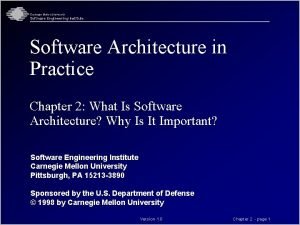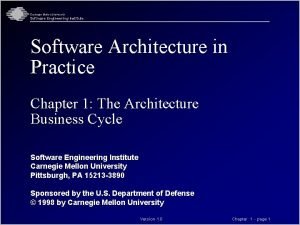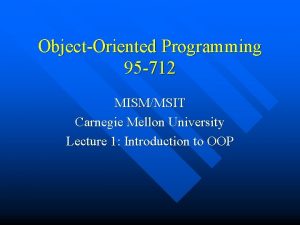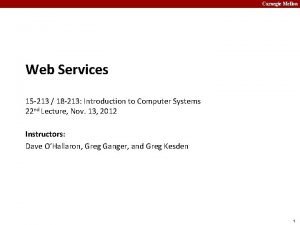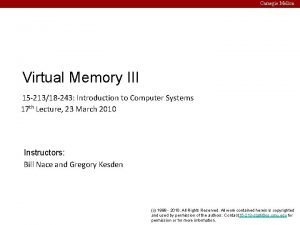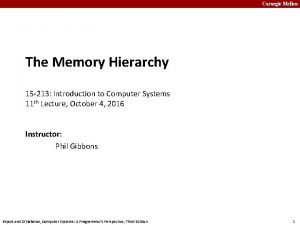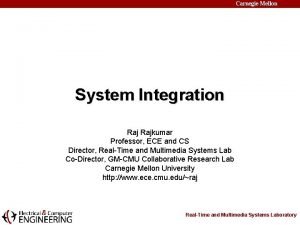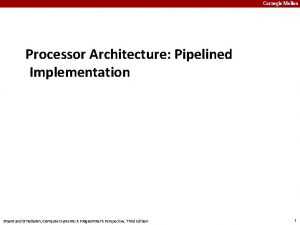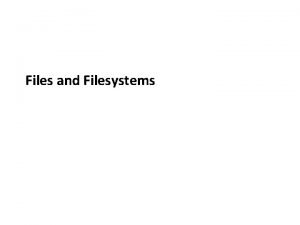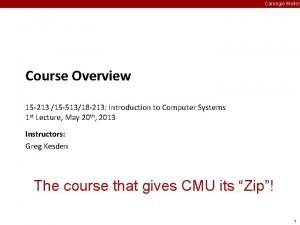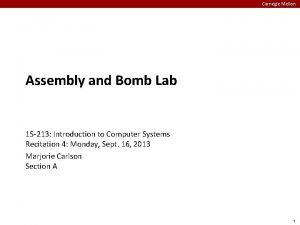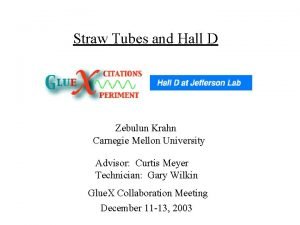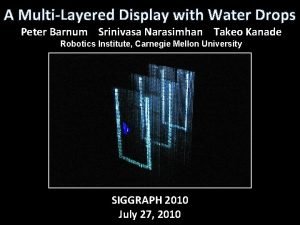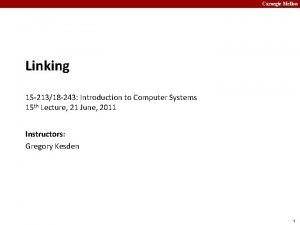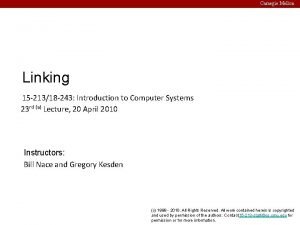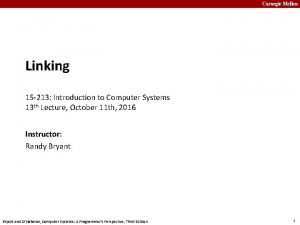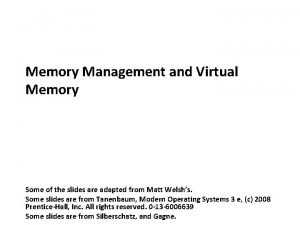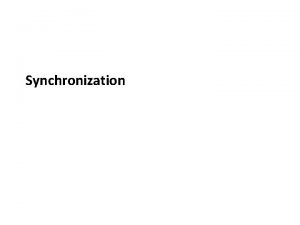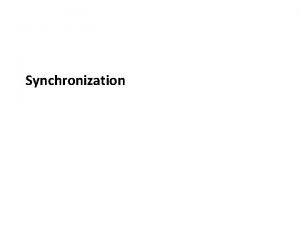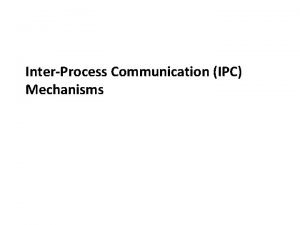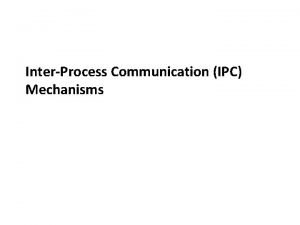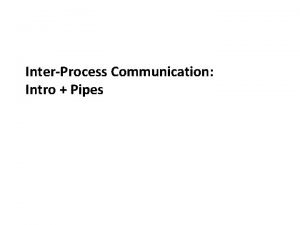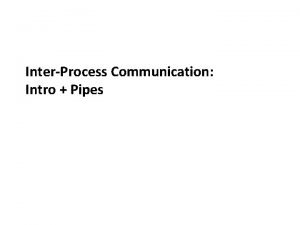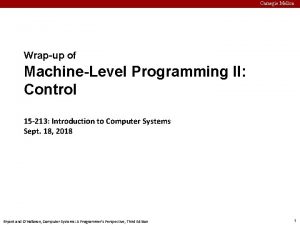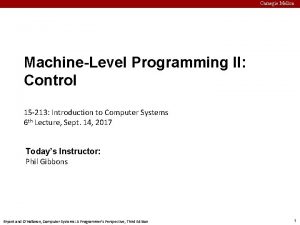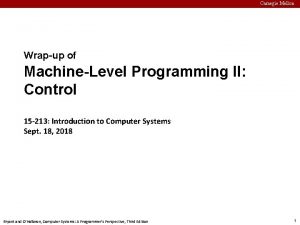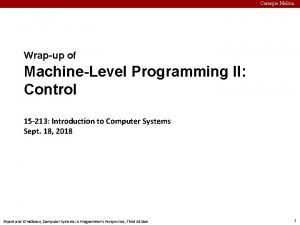Carnegie Mellon Memory Management and Virtual Memory 2
































- Slides: 32

Carnegie Mellon Memory Management and Virtual Memory - 2 Some of the slides are adapted from Matt Welsh’s. Some slides are from Tanenbaum, Modern Operating Systems 3 e, (c) 2008 Prentice-Hall, Inc. All rights reserved. 0 -13 -6006639 Some slides are from Silberschatz, and Gagne.

Carnegie Mellon Page Replacement ¢ ¢ How do we decide which pages to kick out of physical memory when memory is tight? How do we decide how much memory to allocate to a process?

Carnegie Mellon Benefits of sharing pages ¢ How much memory savings do we get from sharing pages across identical processes? § A lot! Use the “top” command. . .

Carnegie Mellon Paging and swapping ¢ ¢ However, on heavily-loaded systems, memory can fill up To achieve good system performance, must move “inactive” pages out to disk If we didn't do this, what options would the system have if memory is full? ? ? § What constitutes an “inactive” page? § How do we choose the right set of pages to copy out to disk? § How do we decide when to move a page back into memory? § ¢ Swapping § Usually refers to moving the memory for an entire process out to disk § This effectively puts the process to sleep until OS decides to swap it back in ¢ Paging out/in § Refers to moving individual pages out to disk (and back) § We often use the terms “paging out” and “swapping” interchangeably

Carnegie Mellon When to Evict Pages ¢ On page fault, when a free page is required § In a loaded system most requests need replacement algorithm to work. § When replacement requires I/O, task needs to sleep. § Performance of tasks reduces, replacement time is added. ¢ Solution: Page Daemon (or swap daemon) § Watches system free memory. Start replacing pages as free memory drops below a threshold. § Maintains a pool of free memory all the time so tasks requiring a new page can find a new page instantly. § It sleeps when there is plenty of memory. Adaptively wake ups more often and replaces more pages as system is low on memory. § In extreme cases, it starts replacing whole memory of tasks (trashing)

Carnegie Mellon Basic Page Replacement ¢ How do we replace pages? § Find the location of the desired page on disk § Find a free frame: If there is a free frame, use it § If there is no free frame, use a page replacement algorithm to select a victim frame § Read the desired page into the (newly) free frame. Update the page and frame tables. § Restart the process §

Carnegie Mellon Page Replacement

Carnegie Mellon Evicting the best page ¢ Goal of the page replacement algorithm: § Reduce page fault rate by selecting the best page to evict ¢ The “best” pages are those that will never be used again § However, it's impossible to know in general whether a page will be touched § If you have information on future access patterns, it is possible to prove that evicting those pages that will be used the furthest in the future will minimize the page fault rate ¢ What is the best algorithm for deciding the order to evict pages? § Much attention has been paid to this problem. § Used to be a very hot research topic. § These days, widely considered solved (at least, solved well enough)

Carnegie Mellon Locality ¢ Exploiting locality § Temporal locality: Memory accessed recently tends to be accessed again soon § Spatial locality: Memory locations near recently-accessed memory is likely to be referenced soon ¢ Locality helps to reduce the frequency of paging § Once something is in memory, it should be used many times ¢ This depends on many things: § The amount of locality and reference patterns in a program § The page replacement policy § The amount of physical memory and the application footprint

Carnegie Mellon Page Replacement Basics ¢ Most page replacement algorithms operate on some data structure that represents physical memory: Free list § Might consist of a bitmap, one bit per physical page § Might be more involved, e. g. , a reference count for each page (remember Shared memory/Co. W? ) § Free list consists of pages that are unallocated ¢ Several ways of implementing this data structure § Scan all process PTEs that correspond to mapped pages (valid bit == 1) § Keep separate linked list of physical pages § Inverted page table: One entry per physical page, each entry points to PTE

Carnegie Mellon Free List ¢ Bitmap representation: n/8 bytes. § i. e. 4 GB = 4 M pages requires 512 KB § More information per frame required if page is not free. i. e. invalidate PTE’s of address translation tables referring an evicted frame. ¢ Linked list of page structures: freelist page page § Allocating a free page and inserting an evicted page is fast. page Insert/remove from the head § Non-free page structures keep reference count, reference to task memory maps, file block info if loaded from a file, state and protection.

Carnegie Mellon Algorithms: Random and FIFO ¢ Random: Throw out a random page § Obviously not the best scheme § Although very easy to implement! ¢ FIFO: Throw out pages in the order that they were allocated § Maintain a list of allocated pages § When the length of the list grows to cover all of physical memory, pop first page off list and allocate it ¢ Why might FIFO be good? ¢ Why might FIFO not be so good?

Carnegie Mellon Algorithms: FIFO ¢ FIFO: Throw out pages in the order that they were allocated § Maintain a list of allocated pages § When the length of the list grows to cover all of physical memory, pop first page off list and allocate it ¢ Why might FIFO be good? § Maybe the page allocated very long ago isn't being used anymore ¢ Why might FIFO not be so good? § Doesn't consider spatial locality! § Suffers from Belady's Anomaly: Performance of an application might get worse as the size of physical memory increases!!!

Carnegie Mellon Belady's Anomaly time Access pattern 0 1 2 3 0 1 4 0 1 2 3 4 Physical memory (3 page frames) 0 0 0 1 2 3 0 0 0 1 4 4 1 1 2 3 0 1 1 1 4 2 2 2 3 0 1 4 4 4 2 3 3 9 page faults! time Access pattern Physical memory (4 page frames) 0 1 2 3 0 1 4 0 1 2 3 4 0 0 1 1 1 2 2 3 0 1 2 3 4 0 3 4 0 1 2 3 4 10 page faults!

Carnegie Mellon Algorithm: OPT (a. k. a MIN) ¢ Evict page that won't be used for the longest time in the future § Of course, this requires that we can foresee the future. . . § So OPT cannot be implemented! ¢ This algorithm has the provably optimal performance § Hence the name “OPT” § Also called “MIN” (for “minimal”) ¢ OPT is useful as a “yardstick” to compare the performance of other (implementable) algorithms against

Carnegie Mellon Algorithm: Least Recently Used (LRU) ¢ Evict the page that was used the longest time ago § Keep track of when pages are referenced to make a better decision § Use past behavior to predict future behavior LRU uses past information, while MIN uses future information § When does LRU work well, and when does it not? § ¢ Implementation § Every time a page is accessed, record a timestamp of the access time § When choosing a page to evict, scan over all pages and throw out page with oldest timestamp ¢ Problems with this implementation?

Carnegie Mellon Algorithm: Least Recently Used (LRU) ¢ Evict the page that was used the longest time ago § Keep track of when pages are referenced to make a better decision § Use past behavior to predict future behavior LRU uses past information, while MIN uses future information § When does LRU work well, and when does it not? § ¢ Implementation § Every time a page is accessed, record a timestamp of the access time § When choosing a page to evict, scan over all pages and throw out page with oldest timestamp ¢ Problems with this implementation? § 32 -bit timestamp for each page would double the size of every PTE § Scanning all of the PTEs for the lowest timestamp would be slow

Carnegie Mellon Approximating LRU: Additional. Reference-Bits ¢ Use the PTE reference bit and a small counter page § (Use a counter of, say, 2 or 3 bits in size, and store it in the PTE) ¢ Periodically (say every 100 msec), scan all physical pages in the system § If the page has not been accessed (PTE reference bit == 0), increment (or shift right) the counter § If the page has been accessed (reference bit == 1), set counter to zero (or shift right) § Clear the PTE reference bit in either case! ¢ Counter will contain the number of scans since the last reference to this page. § PTE that contains the highest counter value is the least recently used § So, evict the page with the highest counter

LRU example time 0 0 0 Carnegie Mellon 0 0 0 0 0 1 1 1 0 0 1 1 0 1 0 1 1 0 0 0 2 0 0 0 1 2 2 0 0 1 0 2 1 0 Accessed pages in blue Increment counter for untouched pages These pages have the highest counter value and can be evicted.

Carnegie Mellon Algorithm: LRU Second-chance (Clock) ¢ ¢ LRU requires searching for the page with the highest last-ref count § Can do this with a sorted list or a second pass to look for the highest value Simpler technique: Second-chance algorithm § “Clock hand” scans over all physical pages in the system § Clock hand loops around to beginning of memory when it gets to end § If PTE reference bit == 1, clear bit and advance hand to give it a second-chance § If PTE reference bit == 0, evict this page § No need for a counter in the PTE! Accessed pages in blue Clock hand Evict!

Carnegie Mellon Algorithm: LRU Second-chance (Clock) ¢ ¢ LRU requires searching for the page with the highest last-ref count § Can do this with a sorted list or a second pass to look for the highest value Simpler technique: Second-chance algorithm § “Clock hand” scans over all physical pages in the system § Clock hand loops around to beginning of memory when it gets to end § If PTE reference bit == 1, clear bit and advance hand to give it a second-chance § If PTE reference bit == 0, evict this page § No need for a counter in the PTE! Accessed pages in blue Clock hand Evict!

Carnegie Mellon Algorithm: LRU Second-chance (Clock) ¢ This is a lot like LRU, but operates in an iterative fashion § To find a page to evict, just start scanning from current clock hand position § What happens if all pages have ref bits set to 1? § What is the minimum “age” of a page that has the ref bit set to 0? ¢ Slight variant -- “nth chance clock” § § Only evict page if hand has swept by N times Increment per-page counter each time hand passes and ref bit is 0 Evict a page if counter >= N Counter cleared to 0 each time page is used

Carnegie Mellon Algorithm: LRU Enhanced Secondchance (Clock) ¢ Be even smarter: Consider the R(eference) bit and the M(odified) bit as an ordered pair to classify pages into four classes § (0, 0) : Neither recently used not modified – best page to replace § (0, 1) : Not recently used but modified – not quite as good, since the page has to be written out before replacement § (1, 0) : recently used but clean – probably will be used again § (1, 1) : recently used and modified – probably will be used again and the page will be need to be written out before it can be replaced ¢ ¢ We may need to scan the circular queue several times. The number of required I/O's reduced. to 0?

Carnegie Mellon Swap Files ¢ What happens to the page that we choose to evict? § Depends on what kind of page it is and what state it's in! ¢ OS maintains one or more swap files or partitions on disk § Special data format for storing pages that have been swapped out Swap files on disk Virtual address space (Reserved for OS) “Zero page” Program executable Physical Memory

Carnegie Mellon Swap Files ¢ How do we keep track of where things are on disk? § Recall PTE format § When V bit is 0, can recycle the PFN field to remember something about the V bit 0 page. 5 bits 24 bits Swap file index Swap file offset Swap file (max 2^24 pages = 64 GB) Swap file table (max 32 entries) ¢ But. . . not all pages are swapped in from swap files! § What about executables? § Or “zero pages”? § How do we deal with these file types?

Carnegie Mellon VM map structure ¢ OS keeps a “map” of the layout of the process address space. § This is separate from the page tables. § In fact, the VM map is used by the OS to lay out the page tables. ¢ This map can indicate where to find pages that are not in memory § e. g. , the disk file ID and the offset into the file. (Reserved for OS) Stack Heap Uninitialized vars (BSS segment) Initialized vars (data segment) Code (text segment) Copy-on-write of zero page or page in from swap (if page was previously modified) Page in from executable or swap (if page was previously modified) Page in from executable file

Carnegie Mellon Page Eviction ¢ ¢ ¢ How we evict a page depends on its type. Code page: § Just remove it from memory – can recover it from the executable file on disk! Unmodified (clean) data page: § If the page has previously been swapped to disk, just remove it from memory Assuming that page's backing store on disk has not been overwritten § If the page has never been swapped to disk, allocate new swap space and write the page to it § Exception: unmodified zero page – no need to write out to swap at all! § ¢ Modified (dirty) data page: § If the page has previously been swapped to disk, write page out to the swap space § If the page has never been swapped to disk, allocate new swap space and write the page to it

Carnegie Mellon Physical Frame Allocation ¢ How do we allocate physical memory across multiple processes? § What if Process A needs to evict a page from Process B? § How do we ensure fairness? § How do we avoid having one process hogging the entire memory of the system? ¢ ¢ ¢ Local replacement algorithms § Per-process limit on the physical memory usage of each process § When a process reaches its limit, it evicts pages from itself Global-replacement algorithms § Physical size of processes can grow and shrink over time § Allow processes to evict pages from other processes Note that one process' paging can impact performance of entire system! § One process that does a lot of paging will induce more disk I/O

Carnegie Mellon Working Set ¢ ¢ A process's working set is the set of pages that it currently “needs” Definition: § WS(P, t, w) = the set of pages that process P accessed in the time interval [tw, t] § “w” is usually counted in terms of number of page references § ¢ ¢ A page is in WS if it was referenced in the last w page references Working set changes over the lifetime of the process § Periods of high locality exhibit smaller working set § Periods of low locality exhibit larger working set Basic idea: Give process enough memory for its working set § If WS is larger than physical memory allocated to process, it will tend to swap § If WS is smaller than memory allocated to process, it's wasteful § This amount of memory grows and shrinks over time

Carnegie Mellon Estimating the working set ¢ ¢ ¢ How do we determine the working set? Simple approach: modified clock algorithm § Sweep the clock hand at fixed time intervals § Record how many seconds since last page reference § All pages referenced in last T seconds are in the working set Now that we know the working set, how do we allocate memory? § If working sets for all processes fit in physical memory, done! § Otherwise, reduce memory allocation of larger processes Idea: Big processes will swap anyway, so let the small jobs run unencumbered § Very similar to shortest-job-first scheduling: give smaller processes better chance of fitting in memory § ¢ How do we decide the working set time limit T? § If T is too large, very few processes will fit in memory § If T is too small, system will spend more time swapping § Which is better?

Carnegie Mellon Page Fault Frequency ¢ ¢ ¢ Dynamically tune memory size of process based on # page faults Monitor page fault rate for each process (faults per sec) If page fault rate above threshold, give process more memory § Should cause process to fault less § Doesn't always work! § ¢ Recall Belady's Anomaly If page fault rate below threshold, reduce memory allocation

Carnegie Mellon Trashing ¢ As system becomes more loaded, spends more of its time paging § Eventually, no useful work gets done! CPU utilization Trashing ¢ System is overcommitted! Number of processes § If the system has too little memory, the page replacement algorithm doesn't matter ¢ Solutions? § Change scheduling priorities to “slow down” processes that are thrashing § Identify process that are hogging the system and kill them? § Is thrashing a problem on systems with only one user?
 Cmu comp bio
Cmu comp bio Carnegie mellon interdisciplinary
Carnegie mellon interdisciplinary Carnegie mellon software architecture
Carnegie mellon software architecture Bomb lab secret phase
Bomb lab secret phase Carnegie mellon software architecture
Carnegie mellon software architecture Cmu sparcs
Cmu sparcs Mism carnegie mellon
Mism carnegie mellon Randy pausch carnegie mellon
Randy pausch carnegie mellon Kevin thompson nsf
Kevin thompson nsf Iit
Iit 18-213 cmu
18-213 cmu Carnegie mellon vpn
Carnegie mellon vpn Carnegie mellon
Carnegie mellon Carnegie mellon
Carnegie mellon Carnegie mellon
Carnegie mellon Carnegie mellon
Carnegie mellon Carnegie mellon fat letter
Carnegie mellon fat letter 15-513 cmu
15-513 cmu Assembly bomb lab
Assembly bomb lab Virtual memory
Virtual memory Virtual memory in memory hierarchy consists of
Virtual memory in memory hierarchy consists of Aging algorithm
Aging algorithm Mellon serbia iskustva
Mellon serbia iskustva Carneigh mellon
Carneigh mellon Self-efficacy theory
Self-efficacy theory Wageworks health equity
Wageworks health equity Mellon tubes
Mellon tubes Water mellon
Water mellon Mellon elf
Mellon elf Mellon elf
Mellon elf Mellon elf
Mellon elf Carnegie and rockefeller venn diagram
Carnegie and rockefeller venn diagram Has virtual functions and accessible non-virtual destructor
Has virtual functions and accessible non-virtual destructor


